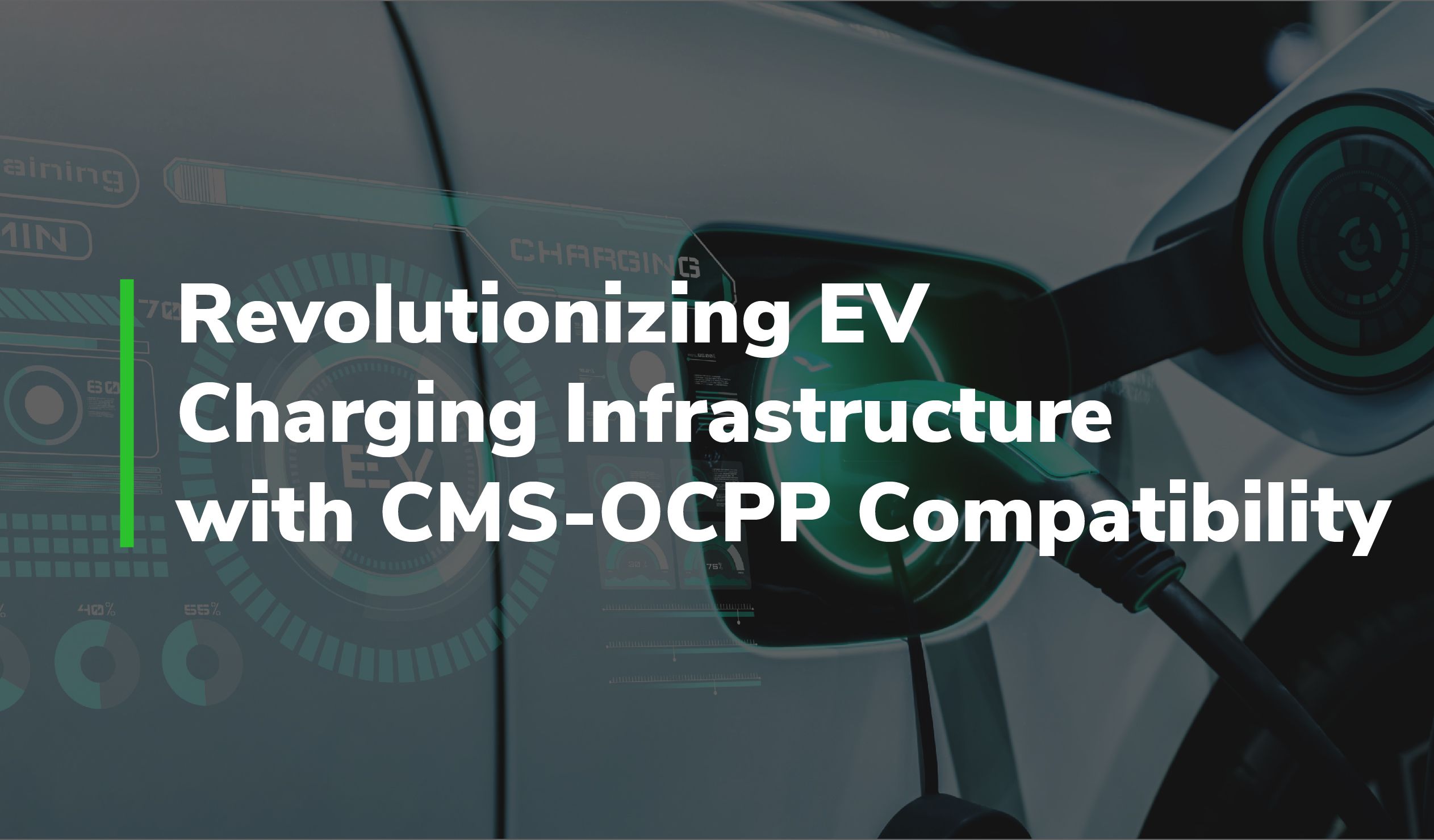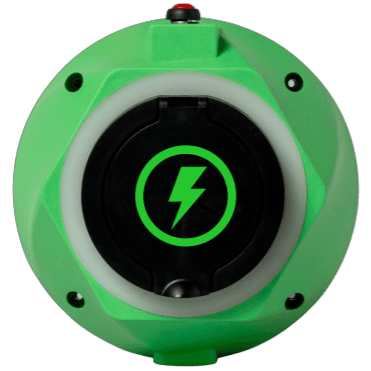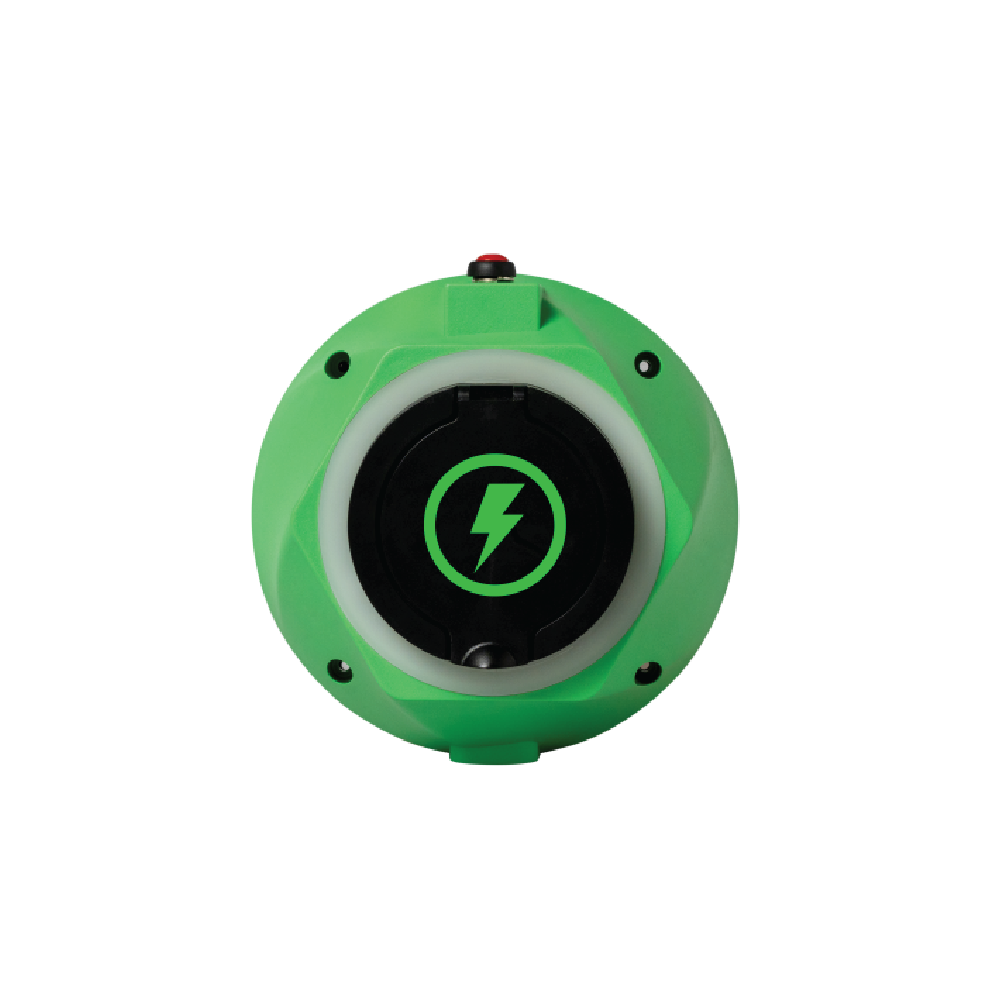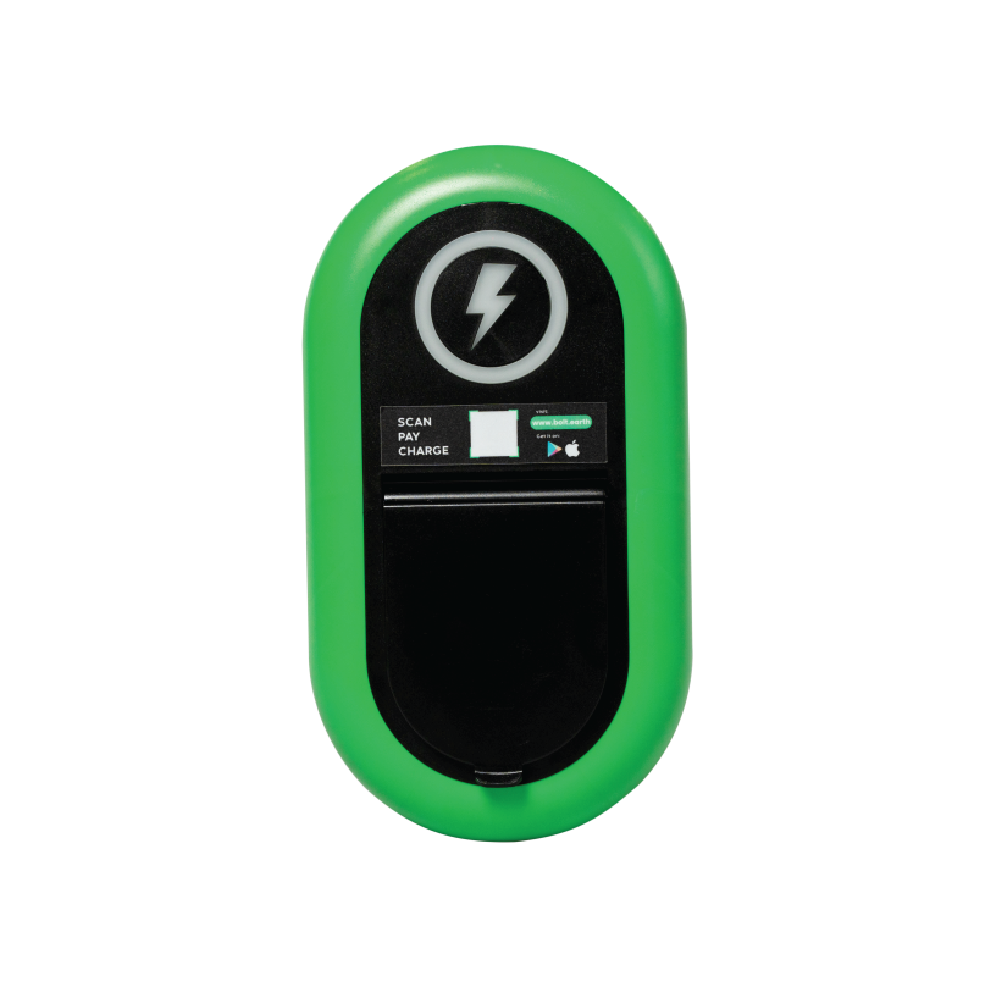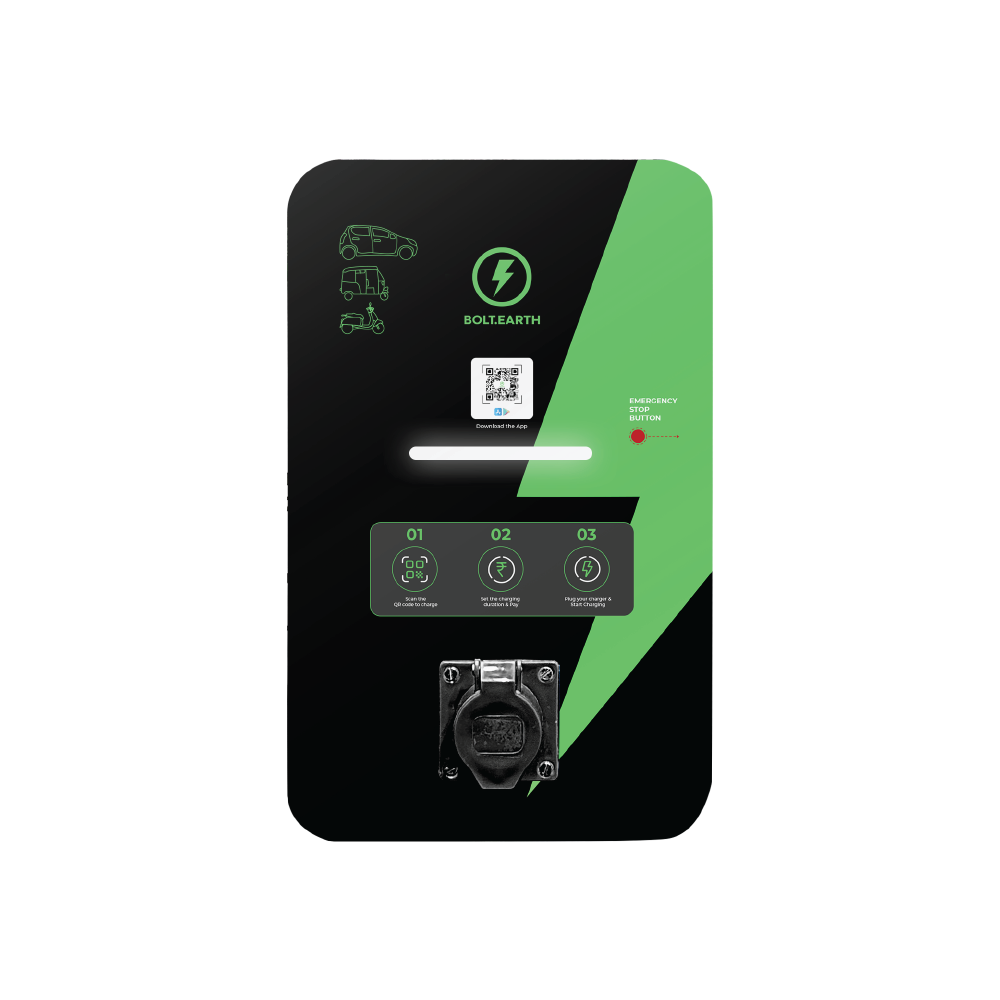An Introduction to Software-Defined Vehicles
Raghav Bharadwaj
Head of Strategy and Leadership

Rapid technological advancements, and the quest for customizable vehicles, have propelled the rise of software-defined vehicles (SDVs): vehicles whose functionalities and underlying hardware are controlled and managed by an operating system.
Software-defined vehicles are unique — they continually evolve and adapt via over-the-air updates. This enables manufacturers to seamlessly introduce new features, improve vehicle performance, customize functionality, and enhance safety, all without the need for physical modifications to the vehicle.
This article will explore the following three questions about software-defined vehicles’ transformative effect on the future of mobility:
- What are software-defined vehicles, and how are they reshaping mobility paradigms in the electric vehicle revolution?
- What challenges and solutions are associated with transitioning to software-defined vehicles, considering factors such as infrastructure readiness, regulations, cybersecurity, and battery technology?
- How can software-defined vehicles impact the future of transportation?
Understanding Software-Defined Vehicles
Software-defined vehicles have had a game-changing effect on the automotive industry, just like the game-changing effect of Android and iOS on the smartphone industry in the 2000s. Smartphone apps have gone on to replace many hardware gadgets, such as alarm clocks, calculators, and radios.
Similarly, SDV software is streamlining automotive hardware functionality, including navigation, battery charging, sensors, diagnostics, and infotainment systems. SDV software is particularly powerful because it can quickly and affordably customize a car to meet a user's evolving requirements — users no longer need to invest in overhauling hardware components.
This paradigm shift in auto manufacturing is fueling the growth of autonomous and electric vehicles, which are particularly well-suited to leveraging the capabilities of SDV software.
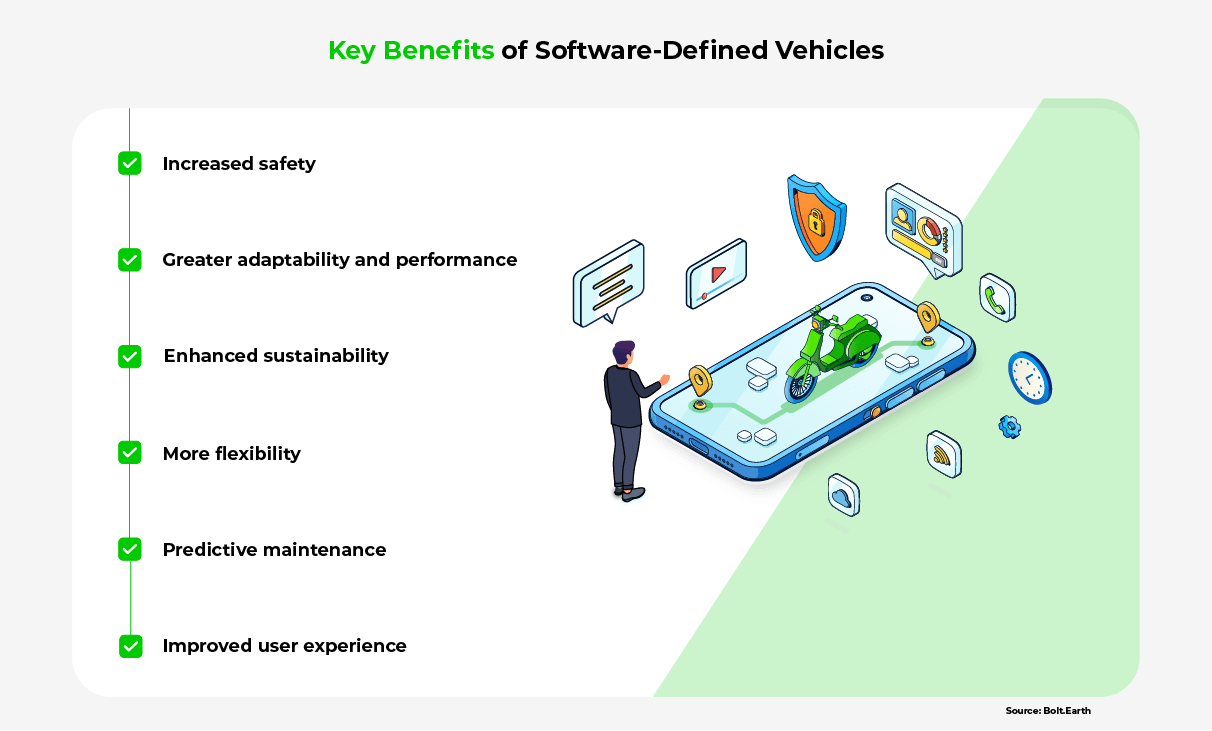
Increased Safety
By sending data to a cloud system for real-time analysis, SDV software enables vehicles to better interact with their surroundings. The vehicle can then receive instructions to avoid certain routes, automatically slow down when it reaches the prescribed speed limits, and so on.
Greater Adaptability and Performance
Software is easier to update than hardware, so a vehicle can continue to improve its efficiency and performance long after it has left the factory. For example, Tesla releases regular software updates to enhance its vehicles’ functionality.
Enhanced Sustainability
Software-defined vehicles last longer than traditional vehicles, since new additions and upgrades can be made directly to the software, with no need to update hardware components.
This obviates the need for additional raw materials and manufacturing processes, thereby eventually contributing to enhanced sustainability. SDVs also bridge the generational gap between vehicle models, reducing the resources needed for recycling and disposal.
More Flexibility
SDV software makes it easier to extend the usability and functionality of a vehicle. For example, the Hummer EV’s "CrabWalk" feature offers greater maneuverability in tight spaces such as narrow roads. The driver can turn on this mode to enable sideways motion and a tighter turning circle.
Predictive Maintenance
Fleet managers and car owners can opt to collect and analyze the data generated by their SDVs. As a result, owners can catch problems early on, and can reduce repair costs by proactively servicing or replacing faulty hardware components right away. Fleet companies can also use the data for fleet routing and predictive maintenance. Additionally, government officials can use data about road conditions to improve the highway infrastructure.
Improved User Experience
SDVs provide automakers with a unique opportunity to continuously improve their products. An SDV’s connected features open endless possibilities like remote cabin heating and cooling, pay-per-use insurance, screen defrosting, and more. With SDVs, automakers can provide value to users by selling functionality upgrades rather than new vehicles, while users can enjoy a customized driving experience.
Growth Trends for Software-Defined Vehicles
Due to drivers’ and fleet operators’ evolving needs, the global SDV market is expected to grow from $34.2 billion in 2022 to $81.6 billion in 2027: an average annual growth rate of 19%.
Currently, North America is seeing the highest growth, powered by buyers’ demand for autonomous and semi-autonomous functionality. In Europe, existing automakers’ investments in IoT, AI, and connected vehicle technologies are expected to propel adoption.
However, the Asia-Pacific region is projected to be the most promising market for SDVs in the next few years, with a surge in demand expected from China, Japan, India, and South Korea.
How Are SDVs Paving the Way for EVs?
SDVs’ modular architecture is fueling innovation in the automotive industry and paving the way for the adoption of sustainable transportation options like EVs. SDVs and EVs are a natural fit for several reasons.
Software Is the Heart of EVs
EVs provide more than just a new kind of engine — they represent the evolution of smart, connected vehicles that are fueled by software to enhance driveability and user experience.
Furthermore, well-developed software is necessary to monitor and maintain EVs’ battery storage, charging system, and other components. As a result, progress in the SDV industry enables greater EV adoption.
Decentralized Power Distribution
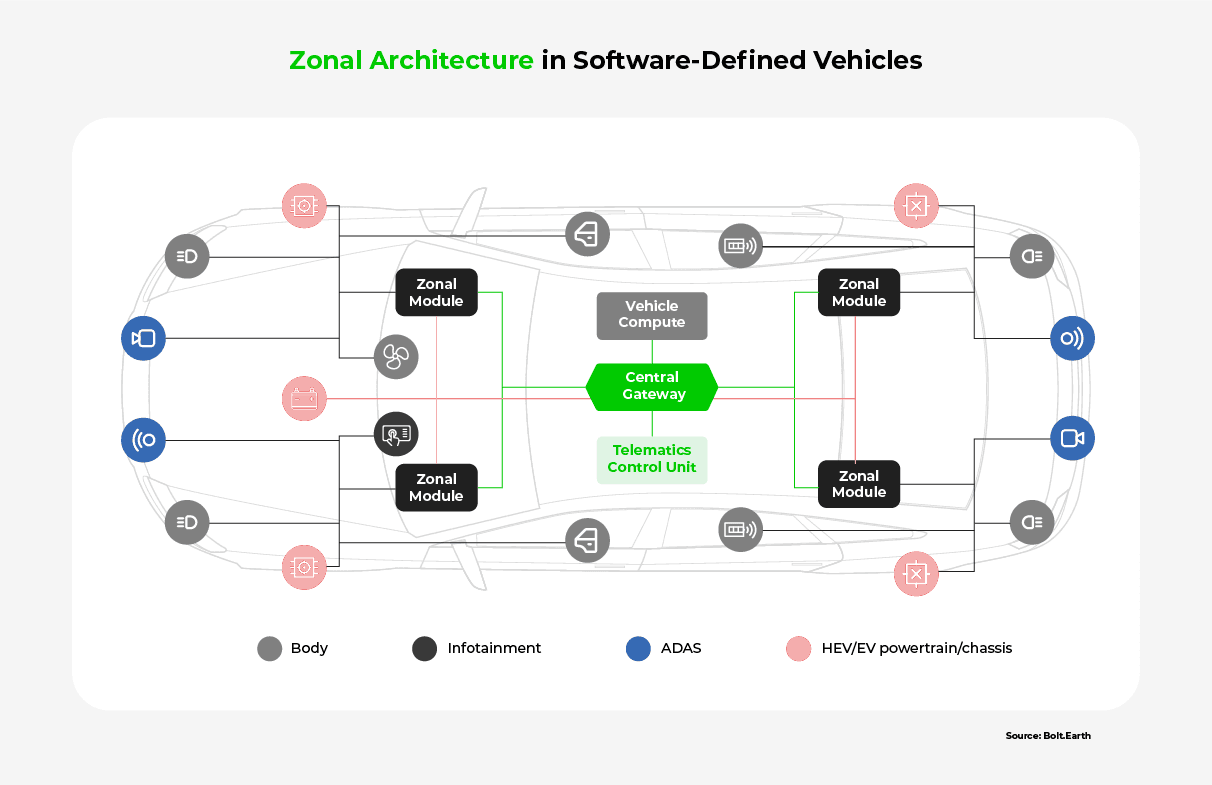
SDVs’ zonal architecture handles power distribution more efficiently than traditional vehicles’ domain architecture does. This enables EVs to get additional mileage from stored battery power, which, in turn, mitigates the technological shortcomings and limited charging infrastructure that are currently fostering range anxiety and thereby hampering EV adoption.
Enhanced Control
SDVs give car owners and fleet managers more control over their vehicles’ performance and health. Over-the-air updates and always-on cloud connections open the door to new services and features such as streamlined EV charging.
A Balance of Customization and Sustainability
SDVs provide drivers with an expanded range of options for features, while EVs bring down emissions and dependence on fossil fuels. As a result, advancements in SDVs can promote the creation and adoption of more EV models that provide an environmentally friendly way to enjoy the driving experience.
Due to these multipronged benefits, many automakers are looking to implement SDV software in EVs.
How Are Software-Defined Vehicles Implemented?
Implementing software-defined vehicles requires a systematic, forward-thinking approach. Here is an overview of the implementation steps and their significance:
1. Analysis and Requirements Gathering
Analyze the existing vehicle system to identify areas for improvement. Involve key stakeholders, like engineers, designers, fleet operators, and potential car owners to ensure the software aligns with everyone's needs and expectations.
2. Design and Planning
Plan the SDV system’s architecture. According to the current architectural trend, the vehicle is divided into multiple zones, each of which has its own central component. This central component controls its zone’s other components, while communicating with the vehicle's central gateway. Keep abreast of these emerging trends and plan a roadmap with milestones to guide the implementation process.
3. Hardware and Software Integration
Based on the design, identify the required hardware components. While deciding, consider hardware-software compatibility, and ensure that the hardware is scalable for future software advancements. Decide on the operating system, communication protocols, and middleware needed to power the vehicle.
4. Network Setup and Sensor Integration
Set up a robust network infrastructure that is connected to sensors for cameras, lidars, radars, and GPS. Ensure seamless communication between different components and subsystems, and integrate them into the cloud system for real-time data collection and analysis.
5. Development, Testing, and Deployment
Develop the software as per design. Thoroughly test the individual components and their integrations for safety, reliability, and performance. Once the system is deemed ready, deploy it in real-world environments, and subject it to further testing and monitoring. Establish maintenance procedures to support ongoing operations and future updates.
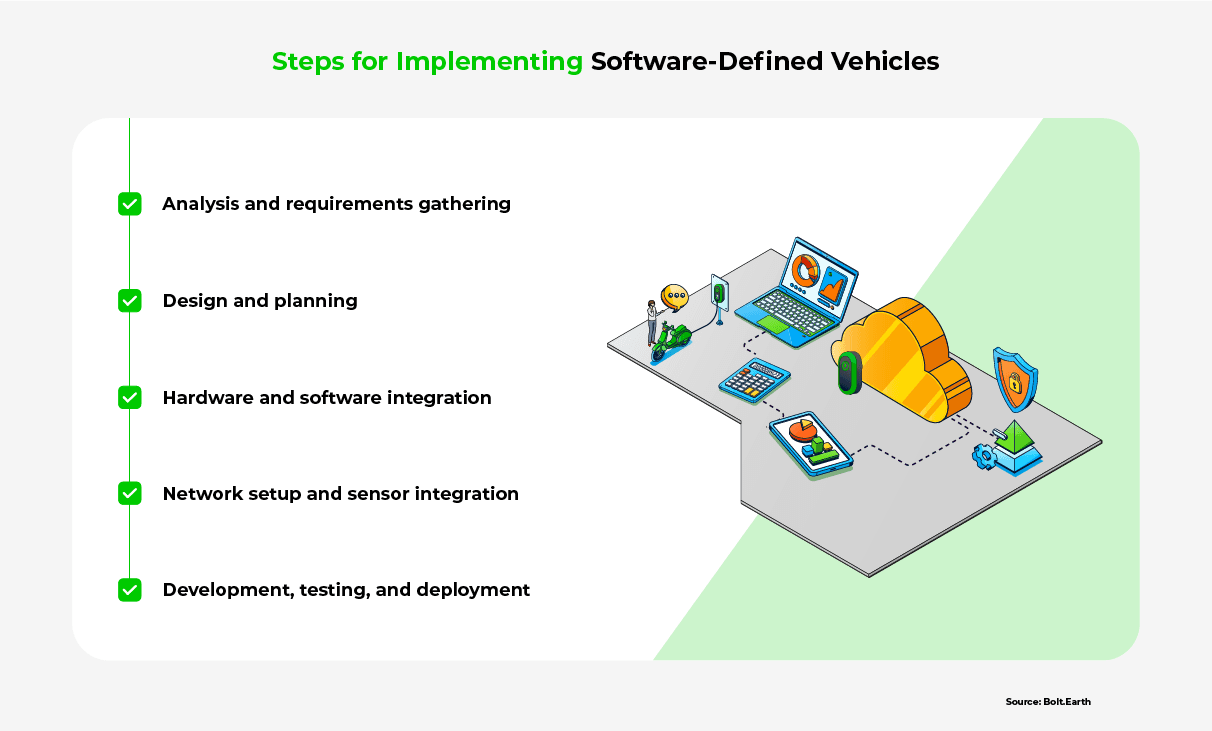
With this systematic approach, EV owners can discover SDVs’ inherent benefits, and automakers and original equipment manufacturers (OEMs) can revolutionize transportation by providing efficient, sustainable, advanced mobility solutions.
However, SDV implementation may not be as simple as it sounds.
Challenges in Implementing Software-Defined Vehicles
Integration issues, cybersecurity and data privacy concerns, and unclear regulations can all impede the development and implementation of SDVs.
Software Development and Integration Challenges
Seamlessly integrating various software components with underlying hardware is integral to SDV functionality. However, ensuring compatibility, interoperability, and reliability of the software stack with the hardware components can be daunting.
Furthermore, in order to guarantee SDVs’ safety and reliability, companies must invest time and money in developing a thorough testing approach and leveraging validation methodologies such as simulation and real-world testing.
OEMs also face new considerations, such as finding suitable open-source platforms and cloud-based development systems to reduce time to market. Finally, because SDV software is still a relatively young industry, it can be difficult to find developers who have the relevant skills.
Cybersecurity and Data Privacy Concerns
Because SDVs rely heavily on software and connectivity, they are potential targets for hacking and unauthorized access. They are also vulnerable to data breaches, since they collect and analyze vast amounts of user data. This means that, by manufacturing SDVs, companies are taking on an additional, and substantial, commitment to implementing robust cybersecurity measures.
Protecting SDVs, and the sensitive data they collect, from potential breaches requires encryption, intrusion detection systems, and secure communication protocols. To build trust with users and ensure compliance with data protection laws, companies must also be prepared to address concerns regarding data ownership, consent, and privacy regulations.
Regulatory and Policy Implications
Existing regulations and standards, such as ISO, are insufficient to monitor the complexity of an SDV because a single vehicle goes through dozens of potentially game-changing upgrades.
For example, by rolling out regenerative braking for its SDV’s autopilot feature, Tesla altered the driving experience in stop-and-go traffic. While this could potentially require a recertification of the braking safety system, the guidelines are not clear. To ensure SDV safety and reliability, policymakers and key stakeholders must create a continuous certification process.
Innovations to Advance SDVs
With ongoing technological advancements and collaboration among all parties in the EV ecosystem, several innovative developments are emerging in the SDV industry.
Unlocking Applications by Making Vehicles Computers
Growing computing capabilities make it possible to treat vehicles as computer systems. To continue the smartphone analogy: an SDV’s OEM software corresponds to a smartphone’s Android or iOS platform.
In turn, this opens up a world of innovative car apps related to vehicle financing, diagnostic, charging systems, e-commerce, and more. In this sense, software-defined vehicles will create a bridge between service providers and consumers.
Artificial Intelligence, Machine Learning, and IoT Integration
IoT systems can collect vast amounts of data from sensors, while AI and ML algorithms can analyze them for intelligent decision-making, predictive maintenance, and autonomous driving.
These systems can also provide real-time insights to improve the overall performance and safety of SDVs. For example, AI-powered algorithms can detect and respond to potential road hazards, optimize energy consumption, and provide personalized driving experiences.
Technological Advancements and Innovations
Research initiatives are exploring cutting-edge technologies, such as edge computing, vehicle-to-everything (V2X) communication, and swarm intelligence, to further enhance the capabilities of SDVs and create a safer and more efficient transportation ecosystem.
Studies estimate that OEM automotive spending will increase by 70%, from $26 billion in 2021 to $43 billion in 2030. Much of this will be in the areas of middleware, automotive cybersecurity, batteries, nanotechnology, and autonomous driving.
Shaping the Future: SDVs’ Global Impact
Software-defined vehicles have the potential to revolutionize the mobility landscape, reshaping every aspect of travel and transportation. Thanks to ongoing advancements in automotive software, connectivity, and automation, SDVs can optimize route planning, minimize traffic congestion, reduce emissions, improve safety, and enable more sustainable transportation and living options.
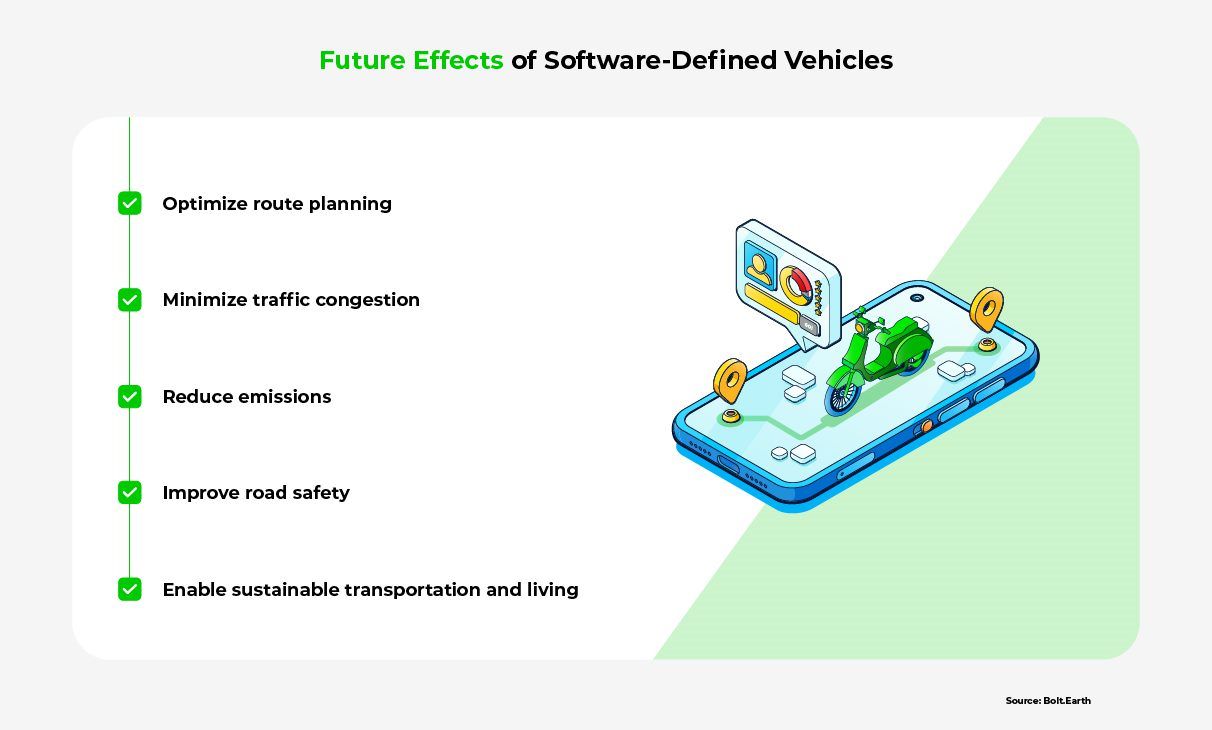
Smart City Integration and Sustainable Infrastructure
Significantly, SDVs can integrate with smart cities and sustainable infrastructure. SDVs can create a more efficient and connected urban environment by interacting with smart city systems for traffic management, parking solutions, and energy optimization.
Transforming Urban Mobility and Congestion Management
Currently, 55% of the world's population lives in urban areas. The United Nations expects this number to rise to 68% by 2050. As urban areas become more crowded, traffic congestion will become increasingly problematic. Shared and autonomous SDVs have the potential to mitigate this by optimizing routes, minimizing empty trips, and enabling efficient utilization of vehicles.
Environmental Sustainability and Reduced Emissions
Electric SDVs have especial potential to significantly decrease reliance on fossil fuels and combat climate change. As renewable energy sources become more prevalent, the adoption of electric SDVs can lead to a greener and more sustainable transportation system.
Embrace the Future by Unlocking the Potential of SDVs
Software-defined vehicles have emerged as a transformative force in the EV industry, offering customizable and adaptable transportation solutions. With their ability to evolve through over-the-air updates, SDVs have the power to reshape mobility paradigms and fuel the global EV revolution.
By embracing SDVs, drivers, fleet owners, and automakers can unlock benefits such as enhanced safety, adaptability, sustainability, and improved user experiences.
The future of SDVs is promising. Due to software advancements, heightened public awareness, growing investments from automakers and technology companies, and continued research and development efforts, the SDV industry’s progress is expected to accelerate in the coming years. As governments and societies continue to recognize the benefits of SDVs, regulatory frameworks and infrastructure investments will also support their widespread adoption.
Overall, embracing SDVs will revolutionize transportation, enhance connectivity, and build greener and smarter cities, paving the way for a more efficient, connected, and sustainable transportation system.
For more information on the role of SDVs in the global EV revolution, please see the FAQ and Resources below.
FAQ
What are software-defined vehicles, and what role do they play in the electric vehicle revolution?
Software-defined vehicles (SDVs) rely on software to control and manage various aspects of a car's operations, including power distribution, battery management, and driving dynamics. By decoupling hardware from software, SDVs offer sustainable customization and adaptability to meet the evolving drivers' needs.
What can software-defined vehicles help achieve?
SDVs’ continuous updates enable improved performance, enhanced safety features, and increased energy efficiency. They also offer remote diagnostics and maintenance, which reduce the need for physical repairs and minimize downtime. Furthermore, SDVs pave the way for autonomous driving capabilities, advanced driver-assistance systems, and seamless integration with smart city infrastructure.
What benefits are unlocked by turning vehicles into computers?
Turning vehicles into computers creates a new ecosystem of products, services, and opportunities for every stakeholder. In particular, it enables vehicles to act as the platform connecting service providers and consumers, while opening up new revenue streams for automakers and OEMs to offer customized solutions to their customers.
How do software-defined vehicles leverage advanced software systems and connectivity to optimize performance and adaptability?
SDVs’ sensors enable intelligent decision-making by gathering real-time data about the vehicle's surroundings. This data, combined with powerful computing capabilities, allows for dynamic adjustments in vehicle settings, such as power distribution, suspension, and steering, to optimize performance and ensure a smooth and safe driving experience.
How do software-defined vehicles enable over-the-air updates, and how does this feature help drivers?
SDVs enable over-the-air updates through their connectivity capabilities, allowing software and firmware updates to be delivered remotely to the vehicle. This feature continuously provides instantaneous safety improvements, bug fixes, and new features, so that drivers can save time and effort by optimizing their vehicles without having to visit a dealership or service center.
Resources
EE Times: Entering the Software-Defined Vehicle Era
Explore the future of automotive software.
Geonovum: Self-Driving Vehicles (SDVs) & Geo-Information
Learn about the impact of self-driving vehicles on the global market.
Diva Portal: System-Level Impacts of Self Driving Vehicles
Explore SDVs’ worldwide impact.
NIST: In-Vehicle Software Defined Networking
Discover how researchers are exploring network designs for enabling data operability.
McKinsey: Rewiring Car Electronics and Software Architecture for the “Roaring 2020s”
Stay abreast of upcoming SDV trends.

